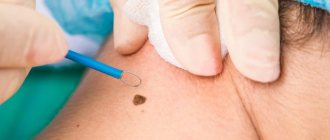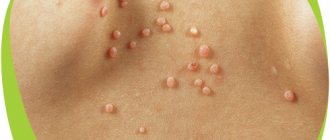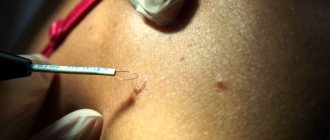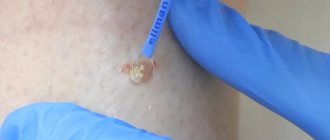A neoplasm is an excessive growth of tissue consisting of modified cells. Pathological cells multiply even after the factors that caused their growth are eliminated, so they are removed. Removing skin tumors requires a special approach, in particular, the procedure should be minimally traumatic and not leave behind unsightly scars.
Appointment with a dermatologist - 1000 rubles. Consultation on diagnostic results (optional) - 500 rubles.
MAKE AN APPOINTMENT, TEST OR ULTRASOUND
What is the radio wave method, when is it used, advantages
The content of the article
The radio wave method of tumor removal involves the focused impact of high-frequency radio waves on the tumor in order to excise it. The radio wave acts like a surgeon's scalpel, but does not leave behind blood, because at high temperatures the blood instantly coagulates. A mole or any other formation is removed along with a small area of healthy tissue. The incision is very small and does not leave any scars.
Removal of tumors using the radio wave method is carried out in the following cases:
- the nevus increases in size, changes color, and hurts;
- neoplasms grow and occupy an increasingly larger area;
- moles change shape and bleed.
The main advantage of the radio wave method is the ability to remove tumors of any type, even those located in the deep layers of the skin. Other advantages of the method include the following:
- no need for stitches or bandages;
- the procedure is completely bloodless, it is suitable for people with blood diseases;
- the operation is performed under topical anesthesia, it does not require anesthesia;
- the procedure lasts 5-20 minutes;
- healing occurs in 3-10 days, depending on the area of the tumors being removed;
- minimal possibility of relapse (no more than 6%);
- used where cryodestruction (exposure to liquid nitrogen) and laser removal is impossible (for example, on the eyelid);
- tissues after removal can be sent for histological examination.
Indications and contraindications for removal of papillomas with Surgitron
Since the Surgitron method of wart removal has many advantages, many doctors recommend it to their patients. The main indications for surgery are neoplasms and papillomas of various parts of the body. This technique can be used even if HPV is detected on the cervix or vagina. It is also ideal for eliminating tumors on the eyelids and in areas of high humidity.
It is forbidden to use Surgitron if there are signs of malignant degeneration of papilloma.
Contraindications:
- Having herpes.
- Pregnancy.
- Presence of a pacemaker.
- State of fever.
In addition, doctors do not recommend removing papillomas for women during menstruation.
Types of tumors removed by radio wave method
Removal of neoplasms using the radio wave method includes the removal of moles, vascular mesh, keratosis, papilloma, fibroma. It is necessary to get rid of tumors, especially if there are certain indications. Each growth on the skin is fraught with a certain danger:
Warts
Warts are neoplasms that arise at the junction of the two upper layers of skin - the epidermis and dermis. The formation rises above the surface of the skin and has a dense stratum corneum. Children are frightened by the fact that warts appear because they touch frogs and toads, and they allegedly infect them with an unknown virus. Warts are actually a type of human papillomavirus.
Sometimes warts appear in adolescence (juvenile warts) during a period of rapid hormonal changes and weakened immunity. Neoplasms in children are eliminated on their own as soon as adolescence passes and immunity is restored. Plantar warts are dangerous. In appearance, they resemble calluses, but constant friction threatens injury and further degeneration into a more aggressive form.
Moles
Moles are benign neoplasms found in almost every person. Moles or naevus maternus are made up of melanin-producing cells. They are dangerous due to their degeneration into basal cell cancer cells and melanoma, a malignant skin tumor. Moles larger than 1 cm in size, with swelling and pigmentation of varying intensity should be removed.
There are various ways to get rid of nevi and moles on the skin, but one of the safest methods is to remove tumors using the radio wave method.
Keratoma
Keratoma is a benign proliferation of epidermal cells (keratinocytes). Due to the exposure of the skin to ultraviolet light, the keratinized cells stop exfoliating, and they accumulate and become keratinized. Keratomas often become injured and bleed. They can degenerate into cancer, so it is recommended to remove them.
Fibroma
Cutaneous fibroma looks like a dense sac localized under a fold of skin. If its height does not exceed 2 cm, it is better not to touch the fibroma.
Papillomas
Papillomas are skin formations that are the result of infection with the human papillomavirus. About 90% of the world's population is infected with HPV, but not all neoplasms have a risk factor. It all depends on the strain of the virus, and sometimes skin manifestations go away on their own. But they have an unaesthetic appearance, so they are often removed from open areas of the skin.
Condylomas
Condylomas are viral tumors on the mucous surfaces of the body. Transmitted only through sexual contact. Some strains are especially dangerous because in 99.9% of cases they cause cervical cancer in women.
Condylomas on the surface of the uterus provoke miscarriage, and in men they cause bladder cancer. Removal of such tumors is carried out using the radio wave method, because it is the most effective and safe.
Types of warts
The most common are warts.
- Vulgar (ordinary)
. They are flat or hemispherical neoplasms of flesh color and are localized mainly on the hands. Painless, do not bleed. - Plantar
. Very dense formations that visually resemble calluses and are located on the soles of the feet. When removed, a plantar wart leaves a crater that is filled with normal tissue over time. The larger and “older” the wart is, the more painful it causes when walking and pressing. Patients often refer to plantar warts as spiny warts. - Flat youthful
. They are located mainly on open areas of the skin (including the face). More common in children and adolescents. Visually they appear as flat formations of a flesh-colored or yellowish-brown color. - Anogenital
. A group of warts found primarily on the genitals. The most common form is genital warts. Unlike other forms, the main route of infection is sexual. Anogenital warts can be transmitted even through protected sexual intercourse.
Preparation for the procedure for removing tumors using the radio wave method
Before the procedure for removing tumors using radio waves, the patient undergoes a medical examination by a doctor. It determines whether the growths are benign or malignant. It also looks to see if the patient has any inflammation or irritation on the skin. The procedure is contraindicated for pregnant women. It is advisable to avoid tanning shortly before removing nevi.
To exclude an undesirable reaction to anesthesia, the patient undergoes drug reaction tests.
Electrocoagulation
Electrocoagulation uses a device that generates an electric current. The electrode or loop that the doctor manipulates becomes very hot. Essentially, the wart is “burned out,” which leads to its destruction. Vessels coagulate under the influence of high temperatures.
This method is considered the most painful of those listed - anesthesia is almost always required. Unfortunately, after electrocoagulation, warts sometimes recur, and the appearance of scars and pigment spots is possible. That is why electrocoagulation is used to remove tumors on open areas of the skin only when other methods are not available.
Removal of moles using a Fotek radio knife, features of removal of tumors of different nature
Radioknife is a device for non-contact removal of formations on the skin using directed exposure to radio waves. It is a tungsten filament electrode in the form of a loop, in which electric current and ionized argon are converted into radio waves. There is no direct contact of the radio knife and the skin, and the excision of a wart or mole occurs due to high-frequency radiation.
The operation is performed under local anesthesia, lasts no more than 20 minutes and allows the removal of both single and group formations. The surrounding tissues are almost not injured, but the affected tissue is removed along with the viral cells, sealing the cut site with temperature.
The Fotek device is a high-frequency surgical electrocoagulator. It has a light and sound system of signals indicating the removal of a mole from the patient's body. Allows you to work in a humid environment, so it is used in gynecology for cauterization of genital warts.
The bipolar electrode is located inside the radioknife, allowing for precise cutting. The mode without coagulation (electrical influence) allows you to remove tumors.
Working with a Fotek radioknife prevents infection, ensuring rapid healing and minimal blood loss.
Removal in honey
If you have warts, you should not ignore them or self-medicate: the papillomavirus is very insidious. We invite you to the CELSIUM Clinic medical center, where an experienced dermatologist will provide comprehensive treatment for human papillomavirus infection (including its external manifestations).
We use cryodestruction and radio wave surgery to remove warts. It is possible to remove a skin tumor immediately on the day of treatment; a consultation with a dermatologist immediately before removal is free. Pre-registration is required, by phone or through the website.
The sooner you make an appointment, the sooner you will get rid of unaesthetic tumors, spending a minimum of time and money on treatment!
What to do after the procedure
The radioknife acts on the tumor, evaporating the tissue. A crust forms at the site of exposure, which quickly heals without leaving a scar. After the procedure, the wound should be treated with a solution of vodka and iodine, and after the crust falls off, with Panthenol wound spray.
If you have at least once applied for removal of tumors, avoid being in direct sunlight. Moles, keratomas and other formations indicate that the skin has a low protective reaction to ultraviolet radiation; melatonin is produced unevenly, accumulating in damaged areas. Even when going outside normally, you should use creams with a high SPF content.
Be sure to strengthen your immune system, because HPV indicates a weakening of the body’s immune functions. After the procedure, you should visit a dermatologist every year.
How exactly is papilloma removed?
Before the procedure, you must visit a dermatologist. This is a mandatory requirement that cannot be ignored. The preliminary consultation is quick. The doctor examines the skin, clarifies complaints, and excludes contraindications. If all points are in perfect order, and the patient wants to get rid of papilloma as soon as possible, the procedure can be carried out immediately after admission.
How does the removal proceed? The patient is placed on the couch and asked to sit comfortably. The doctor then administers an individually selected pain reliever.
This may be a topical cream, an injection under the base of the papilloma, or irrigation of the intervention area with a special spray. Once the painkiller takes effect, the doctor begins the excision. The procedure itself lasts from 10 to 30 minutes and depends on the specifics of the formation, its size/structure, etc. The doctor selects the required distance, intensity, and depth of the wave, after which he acts on the tumor until it is completely excised.
Prices for removal of warts and other tumors
Due to the sharp change in the ruble exchange rate and logistics problems with suppliers, PLEASE CHECK CURRENT PRICES AND AVAILABILITY OF DRUGS BY PHONE
Dermatology
- Primary appointment with a dermatologist (trichologist) (without dermatoscopy)
1200 rub.
- Repeated appointment with a dermatologist (trichologist) (without dermatoscopy) (no more than 2 months from the previous appointment)
900 rub.
- Dermatoscopy
450 rub.
- Examination of the scalp under magnification (trichology)
800 rub
- Wood's lamp examination
250 rub.
- Histological examination of the material
2300 rub.
Removal of skin tumors
- Removal (radio wave destruction) of milia, papillomas, small benign neoplasms, pinpoint angiomas, acne elements, molluscum contagiosum:
- 1 element
500 rub
- from 10 elements
400 rub
- From 20 elements
300 rub
- From 50 elements
200 rub
- Removal of a neoplasm on the eyelid – 1 element
900 rub.
- Removal of telangiectasia – 1 sq.cm (radio wave destruction)
900 rub.
- Removal of benign neoplasms (keratoma, fibroma, etc.) - 1 element (radio wave destruction or cryodestruction). Anesthesia included in the price
:
- D
1100 rub.
* - D = 0.5 - 1 cm
1500 rub.
* - D > 1 cm
1900 rub.
* - Removal of palmar warts – 1 element. Anesthesia is included in the price.
1000 rub
- Removal of plantar warts – 1 element (up to 0.5 cm). Anesthesia is included in the price.
1200 rub.
- Removal of plantar warts – 1 element (more than 0.5 cm). Anesthesia is included in the price.
1500 rub.
- Radiosurgical removal of benign melanocytic and non-melanocytic formations (moles, wen, etc.) - 1 element. Anesthesia included in the price:
- D
1500 rub.
* - D = 0.5 - 1 cm
2000 rub
* - D > 1 cm
2500 rub.
* - Treatment of an area of the scalp for radiosurgical removal of a tumor
400 rub
- * For simultaneous removal of 5-9 formations - 5% discount; For simultaneous removal of more than 10 formations - 10% discount
Anesthesia for extractions
- Application anesthesia (cream, spray)
200 rub
- Injection anesthesia (1 ampoule)
600 rub
Scar tissue treatment
- Treatment of scar tissue (cryodestruction) – area up to 1.5 cm
1500 rub.
- Intramuscular injection of the drug (without the cost of the drug)
500 rub
- Intralesional injection of the drug in the scalp area (without the cost of the drug)
1500 rub.
- Intralesional injection of the drug (without the cost of the drug)
800 rub
- Diprospan
850 rub.
Laboratory research
- Collection of biological material
300 rub
- Cytological examination of scrapings and impressions from the surface of the skin and mucous membranes
1100 rub.
- Microscopy and culture for parasitic fungi (nails)
1700 rub.
- Microscopy and culture for parasitic fungi (skin)
1700 rub.
- Parasitic fungi, microscopic examination of skin samples
1100 rub.
- Parasitic fungi, microscopic examination of nail samples
1100 rub.
- Demodex test, microscopy (skin, abscess discharge)
1100 rub.
- Demodex test (eyelashes)
1100 rub.
- Sowing of wound discharge and tissues for flora and sensitivity to antimicrobial drugs
1400 rub.
- Culture of microflora, determination of sensitivity to antimicrobial drugs and bacteriophages
1500 rub.
- Sowing of wound discharge and tissues for flora and sensitivity to antimicrobial drugs according to the extended spectrum
2100 rub.











